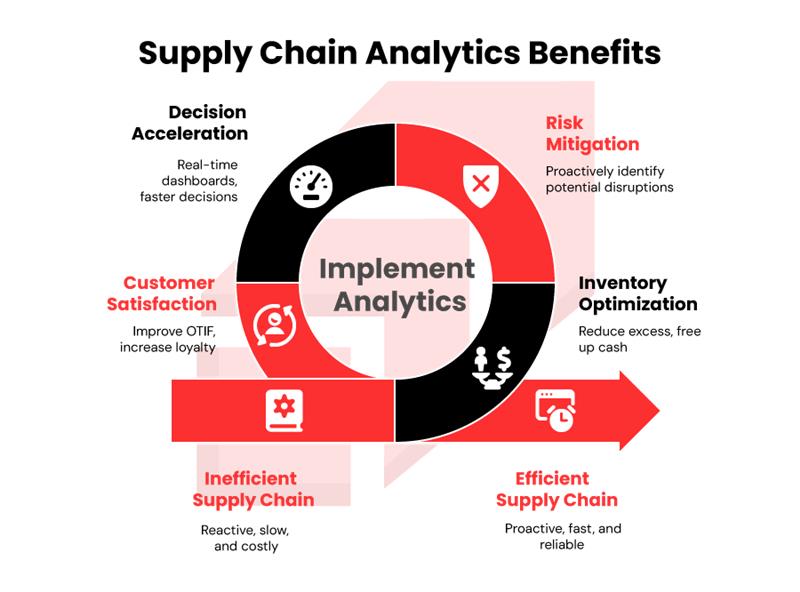If you’ve ever found yourself asking what is supply chain analytics at quarter-end while juggling stockouts, expedited freight, and pushy forecasts, you’re not alone. In plain terms, supply chains are now data chains. Signals that are pulsing from ERP, WMS, TMS, POS, IoT sensors, supplier portals, and even weather feeds. The winners are the teams that turn those signals into decisions faster than competitors.
That’s the heart of data analytics in supply chain management: using statistics, machine learning, and optimization to sense demand, plan supply, and keep promises without burning cash. When leaders nail this, firefighting slows, margins stabilize, and customers feel the difference. More B2B decision-makers now want a crisp, actionable answer to what is supply chain analytics because the stakes are real: service levels, working capital, and resilience.
Throughout this guide, we’ll unpack the importance of supply chain analytics, show practical supply chain analytics use cases, spotlight the tools used in supply chain analytics, and wrap with supply chain analytics trends and the future of supply chain analytics. By the end, what is supply chain analytics won’t be a question; it’ll be your new operating system.
Data Analytics and Supply Chain Management
Data analytics and supply chain management are inseparable in today’s volatile markets. Supply chains throw off endless signals—orders, lead times, inventory movements, shipment delays—and analytics turns that noise into foresight. Instead of relying on gut feel, leaders can sense demand shifts, spot supplier risks, and adjust logistics before issues escalate. This fusion of data analytics and supply chain management moves teams from reactive firefighting to proactive control. The result: smarter planning, leaner operations, and a more resilient business model where cost, service, and agility all align.
What Is Supply Chain Analytics?
So, what is supply chain analytics; really? It’s the disciplined use of data, statistical methods, and advanced algorithms to understand, predict, and improve performance across plan, source, make, deliver, and return.
Put differently, data analytics in supply chain management converts raw signals like orders, receipts, lead times, yields, transit times, into insights that drive actions. It spans three big arcs: seeing what’s happening, anticipating what’s next, and optimizing what to do.
This is not “just dashboards.” Traditional BI tells you what happened. Supply chain analytics goes further to reveal why it happened, what’s likely next, and what to do about it. When someone asks what is supply chain analytics, the practical answer is: a layered toolkit that merges statistics, machine learning, and operations research to raise service and lower cost; simultaneously.
Traditional Supply Chain vs. Data-Driven Supply Chain
A helpful way to cement what is supply chain analytics is to contrast old vs. new operating models. Traditional approaches lean on tribal knowledge and historical averages. Data-driven supply chains institutionalize learning from data, reacting earlier and with more confidence.
Here’s a rephrased side-by-side snapshot:
Aspect |
Traditional Supply Chain |
Data-Driven Supply Chain |
| Approach | Reactive, experience-based | Proactive, analytics-driven |
| Decision-Making | Gut feel and coarse history | Real-time signals, predictive models |
| Visibility | Siloed, lagging | End-to-end, near-real-time |
| Demand Forecasting | Manual, often rough | AI/ML-enabled, improved accuracy |
| Risk Management | Respond after disruption | Sense early, mitigate in advance |
| Data Usage | Minimal, fragmented | Integrated, curated, shared |
| Efficiency | Manual, error-prone | Automated, streamlined |
| Technology | ERP-centric, limited analytics | AI, ML, IoT, optimization |
| Responsiveness | Slow to market shifts | Agile, adaptive |
| Collaboration | Mostly internal | Networked with suppliers/customers |
When leaders ask what is supply chain analytics, the best answer is: it’s the engine that powers this network; aligning visibility, prediction, and action so cash, cost, and service all move the right way.
Importance of Supply Chain Analytics for Businesses
Let’s anchor the importance of supply chain analytics with the pain points it solves.
Reducing operational costs:
Analytics pinpoints where cash hides, excess safety stock, stale SKUs, and low-yield lanes. By segmenting demand, you can right-size buffers and smooth production. Transportation analytics selects better modes and load plans, cutting expedites. Benefits of supply chain analytics show up fast in carrying cost, pick productivity, and fewer firefights.
Improving demand forecasting and planning:
classical monthly forecasts miss near-term shifts; predictive models ingest more signals and update often. This is data analytics and supply chain management working together.
Enhancing agility and risk mitigation:
Analytics quantifies and runs scenarios before storms hit. In practice, that means having alternate suppliers pre-qualified, dynamic reorder points, and clear triggers for capacity shifts.
Building a resilient and competitive supply chain:
Resilience isn’t hoarding inventory; it’s sensing, deciding, and acting faster. With analytical S&OP/IBP, you stress-test plans against plausible futures, so your commitments to customers are robust. That’s a direct path to better OTIF and happier accounts.
Supporting strategic B2B decisions:
Portfolio pruning, price/pack architecture, network redesign, and supplier partnerships all benefit from hard data. When the C-suite asks what is supply chain analytics good for beyond operations, the answer is simple: it sharpens capital allocation and de-risks growth bets.
Types of Supply Chain Analytics
The five-layer model is a practical way to teach what is supply chain analytics to any audience:
Descriptive: What Happened?
Descriptive analytics summarizes history: orders, shipments, service, and cost. It turns raw transactions into KPIs and trend lines so teams see reality the same way. The goal isn’t flashy charts; it’s trustworthy baselines, forecast accuracy by family, days of supply by site, on-time performance by carrier. Done well, descriptive analytics slashes meeting time arguing over numbers and frees energy to solve problems.
Diagnostic: Why Did It Happen?
When something breaks, stockouts, late orders, excess, diagnostic analytics hunts the root cause. Techniques include cohort analysis, variance decomposition, and drilling from aggregate to item-location-week. The mindset shift here clarifies the importance of supply chain analytics: instead of patching symptoms, you fix the system.
Predictive: What’s Likely to Happen Next?
Predictive models forecast demand, lead times, and risk probabilities. They ingest seasonality, promotions, and external signals to produce better priors for planning. In practical supply chain analytics use cases, predictive demand feeds MRP; predictive lead times set safety stock and reorder points; predictive risk flags suppliers or lanes trending the wrong way.
Prescriptive: What Should We Do About It?
Prescriptive analytics uses optimization and simulation to recommend actions: production schedules, inventory policies, transportation plans, and network layouts. It bakes in constraints, capacity, labor, MOQ, service targets, and finds the best feasible plan. Among the benefits of supply chain analytics, this is the most tangible: fewer expedites, smarter inventory, lower landed cost. It’s the math that turns insight into impact.
Cognitive: How Does the System Keep Learning?
Cognitive analytics layers in feedback loops and human-in-the-loop learning. Planners accept or override recommendations; the system learns from those decisions, improving over time. This is where the future of supply chain analytics is headed: explainable, collaborative decisioning that feels like a seasoned colleague whispering in your ear.
How Does Supply Chain Analytics Work?
Understanding what is supply chain analytics gets clearer when we break down its engine.
Supply chain analytics isn’t magic; it’s a disciplined flow: Collect → Clean → Model → Visualize → Decide.
Let’s unpack this.
Firstly, Data Sources – Modern supply chains throw off signals from everywhere:
- ERP systems (orders, invoices, production data)
- Warehouse Management Systems (inventory levels, pick accuracy, throughput)
- Transportation Management Systems (lane cost, transit time, carrier reliability)
- Supplier Portals and EDI feeds (commitments, lead times)
- Market signals (point-of-sale, distributor sell-through, social chatter)
- External data (weather, macroeconomic indicators, geopolitical risk, ESG metrics)
The goal is to stitch these into one data backbone. Without it, analytics is fragmented, teams argue over whose spreadsheet is right.
Second, Data Processing – Raw supply chain data is noisy. Duplicate SKUs, inconsistent units, delayed updates. That’s why master data management and data governance matter. A safety stock algorithm using bad lead times is worse than no model at all. Cleaning, standardizing, and validating data turns noise into a signal you can trust.
Third, Modelling & Visualization – This is where statistical methods and machine learning come into play; forecast models, inventory policies, risk scores. Visualization layers then translate math into human-friendly decisions. The key is embedding these outputs into workflows: a planner should see suggested order quantities inside the planning system, not buried in an email attachment.
And finally, Decision-making & Feedback – The most mature organizations don’t stop at reports, they automate repeatable decisions, and escalate exceptions. Over time, feedback loops let the system learn. That’s how analytics shifts from a report card to an operating system.
Tools Used in Supply Chain Analytics
Tools fall into categories:
Planning Suites
- SAP Integrated Business Planning: Strong for demand, inventory, and response planning.
- Oracle SCM Cloud: Cloud-native with broad functionality.
- Kinaxis RapidResponse: Scenario-based S&OP and concurrent planning.
Execution Analytics
- IBM Sterling: Strength in order orchestration and fulfillment visibility.
- Blue Yonder (JDA): Demand and supply planning with AI-driven insights.
Visualization and BI Tools
- Qlik, Tableau, Power BI turn ERP/WMS/TMS data into interactive dashboards.
Optimization and AI/ML Platforms
- Llamasoft (Coupa) for network design and what-if scenarios.
- DataRobot, AWS Sagemaker, Azure ML for machine learning models.
- Python / R ecosystems for custom analytics.
When leaders ask, what is supply chain analytics without tools the answer is: theory.
Benefits of Supply Chain Analytics for B2B Organizations

The benefits of supply chain analytics explain why more executives are asking what is supply chain analytics in the first place.
Here are the core wins:
- ROI and Working-Capital Efficiency: Analytics trims excess inventory while protecting service. That means fewer dollars tied up in slow movers and more cash freed for growth.
- Proactive Risk Identification: Instead of reacting to missed deliveries, analytics flags supplier delays, lane congestion, or rising defect rates early.
- Faster, Better Decisions: With real-time dashboards and prescriptive recommendations, teams decide in hours, not weeks.
- Happier Customers: OTIF improves when forecasts sharpen and logistics align. Customers feel reliability, and loyalty rises.
- Sustainable Advantage: Competitors stuck in gut-driven cycles bleed cash on expedites and excess.
Supply Chain Analytics Use Cases
Theory comes alive in supply chain analytics use cases. Here are a few where data analytics and supply chain management intersect with measurable value:
- Forecasting & Inventory Optimization: Machine learning forecasts plus inventory simulation balance service and stock. For instance, a distributor cut $15M in excess inventory by adjusting safety stock based on predictive demand variability.
- Supplier Risk Management: Analytics monitors supplier OTIF, lead-time variability, and financial signals. When a key supplier’s reliability dropped, one manufacturer proactively onboarded a backup vendor, avoiding a costly line shutdown.
- Transportation Optimization: TMS analytics evaluates mode, route, and carrier trade-offs. Companies cut freight costs 8–12% by shifting to optimal carrier mixes.
- Integrated Business Planning: Scenario modeling allows leadership to see revenue, margin, and service trade-offs under multiple demand futures.
- Sustainability & ESG Tracking: Analytics measures carbon per ton-mile, packaging efficiency, and supplier sustainability ratings. Increasingly, the future of supply chain analytics is sustainability by default, balancing profit and planet.
Future Trends in Supply Chain Analytics
Peeking into the future of supply chain analytics, several trends stand out:
- AI & ML Everywhere: Forecasts, routing, risk detection, and even supplier negotiations increasingly lean on machine learning. Models that learn continuously will outpace static planning cycles.
- Predictive & Prescriptive Dominate: Descriptive dashboards are table stakes. The next decade is about “what’s next?” and “what should we do?”; with prescriptive recommendations baked into planning systems.
- Real-Time and Edge Analytics: As IoT proliferates, analytics moves to the edge, processing data locally for instant decisions.
- Digital Twins and Scenario Simulation: Virtual replicas of supply chains allow stress-testing against shocks before they happen.
- Sustainability Analytics as Default: Regulations and customer expectations will force carbon, water, and waste metrics into the core dashboard; no longer “nice to have.”
Tomorrow’s leaders won’t be the ones asking what is supply chain analytics; they’ll be the ones embedding it so deeply, it disappears into daily decisions.
How to Adopt Supply Chain Analytics in Your Organization
Adoption is not about buying a tool and hoping for miracles; it’s about building maturity step by step. Here’s a practical roadmap:
- Assess Maturity and Identify Data Gaps: Start with a diagnostic. How clean is your data? Where are the biggest blind spots, forecasting, supplier risk, logistics cost? Map today’s state to tomorrow’s ambition.
- Pick KPIs That Matter: Don’t drown in metrics. Focus on KPIs that drive financial or service outcomes, forecast accuracy, OTIF, inventory turns, expedite costs. Every analytics project should tie directly to a measurable business win.
- Choose Tools and Build the Stack: Whether it’s SAP IBP, Kinaxis, or Power BI, pick tools that align with your problems, not just vendor hype. A lightweight BI rollout may deliver more value than a bloated suite.
- Train People and Form Cross-Functional Squads: Analytics fails without adoption. Invest in training planners, buyers, and logistics staff to use insights. Cross-functional squads ensure analytics outputs don’t stay siloed.
- Build an Agile Roadmap and Show Quick Wins: Instead of a multi-year “big bang,” deliver quick proof points, a 10% forecast improvement, a 5% freight savings. Momentum fuels credibility, unlocking bigger projects.
Ultimately, adopting analytics is a cultural shift: from gut-based to data-based decision-making. Leaders asking what is supply chain analytics for us should tie it to business outcomes, not vanity dashboards.
Conclusion
So, what is supply chain analytics? It’s the discipline of turning messy supply chain data into foresight, decisions, and resilience. It’s not just dashboards; it’s the engine behind demand sensing, inventory optimization, supplier risk management, and network design. For B2B leaders, the importance of supply chain analytics is existential, margins, service, and competitiveness depend on it.
The future promises even more power; AI, digital twins, real-time signals, sustainability metrics. But you don’t have to wait for tomorrow. Start with today’s pain points, build quick wins, and let momentum grow.
In a volatile world, analytics is no longer a luxury. It’s the compass, the map, and the autopilot keeping supply chains alive and profitable.







